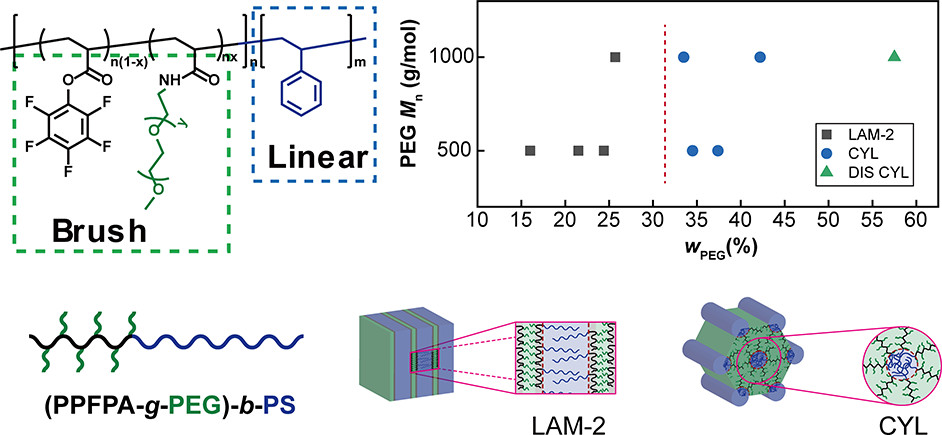“Side-Chain Density Driven Morphology Transition in Brush−Linear Diblock Copolymers” by Jaemin Park, Jiyun Nam, Myungeun Seo and Sheng Li was published in ACS Macro Letters in collaboration of the Li and the Seo groups at KAIST.
Linear-b-brush diblock copolymers are one of the intriguing classes of complex polymeric architecture. Several ordered phases, including lamellae, hexagonally packed cylinders, and body-centered cubic spheres, have been identified with modulation of side-chain length, side-chain density, and block composition of linear-b-brush diblock copolymers. Among them, the density of the side chain is known to be a dominant factor in magnifying the stiffness of the backbone leading to the formation of rod-like conformation. However, elucidating side-chain density-driven phase separation of the linear-b-brush diblock copolymer has been limited as short and noncovalently attached side chains has been typically used.
Through postpolymerization modification, the Li group developed a synthesis route to linear-b-brush diblock copolymers with different side-chain densities and chain lengths. A reaction between a pentafluorophenyl moiety at poly(pentafluorophenyl acrylate)-b-polystyrene (PPFPA-b-PS) diblock polymer with amine-functionalized poly(ethylene glycol) (PEG) afforded the target polymer with sufficiently long PEG side chains in high conversion. At low PEG side chain density, the segregation of PEG and PS away from PPFPA results in PEG and PS lamellar domains while PPFPA lies at the interface. On the other hand, the increase of PEG side chain density stiffens the brush segment, and microphase separation occurs between the brush and the linear blocks. Segregation of the PS segment from the PPFPA-g-PEG matrix affords hexagonally packed cylinders due to its highly asymmetric structure.
The paper is available at the following link:
https://pubs.acs.org/doi/abs/10.1021/acsmacrolett.2c00068


